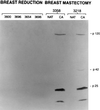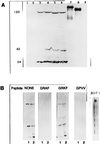Human immunodeficiency virus type 1-like DNA sequences and immunoreactive viral particles with unique association with breast cancer
- PMID: 9729531
- PMCID: PMC95635
- DOI: 10.1128/CDLI.5.5.645-653.1998
Human immunodeficiency virus type 1-like DNA sequences and immunoreactive viral particles with unique association with breast cancer
Abstract
RAK antigens p120, p42, and p25 exhibit molecular and immunological similarity to the proteins encoded by human immunodeficiency virus type 1 (HIV-1) and are expressed by 95% of breast and gynecological cancer cases in women and prostate cancer cases in men. The binding of an epitope-specific anti-HIV-1 gp120 monoclonal antibody (MAb) (amino acids 308 to 322) to cancer RAK antigens has been found to be inhibited by a peptide derived from variable loop V3 of HIV-1. Breast cancer DNAs of 40 patients were PCR amplified with HIV-1 gp41-derived primers, and all of the samples were found to be positive. The DNA fragments amplified in seven blindly selected breast cancer samples were sequenced. The breast cancer DNA sequences showed at least 90% homology to the HIV-1 gene for gp41. Antisense oligonucleotides complementary to the HIV-1-like sequences inhibited reverse transcriptase activity and inhibited the growth of breast cancer cells in vitro. Viral particles detected in breast cancer cell lines were strongly immunogold labeled with the anti-HIV-1 gp120 MAb. The results obtained strongly suggest that the long-postulated breast cancer virus may, in fact, be related to HIV-1.
Figures










Similar articles
-
Giant syncytia and virus-like particles in ovarian carcinoma cells isolated from ascites fluid.Clin Diagn Lab Immunol. 1999 Jan;6(1):115-26. doi: 10.1128/CDLI.6.1.115-126.1999. Clin Diagn Lab Immunol. 1999. PMID: 9874674 Free PMC article.
-
Relevance of the viral RAK alpha gene in diagnosis of malignant versus nonmalignant tumors of the ovary and uterus.Clin Diagn Lab Immunol. 2000 May;7(3):360-5. doi: 10.1128/CDLI.7.3.360-365.2000. Clin Diagn Lab Immunol. 2000. PMID: 10799446 Free PMC article.
-
Prostate, breast and gynecological cancer markers RAK with homology to HIV-1.Cancer Lett. 1998 Feb 27;124(2):213-23. doi: 10.1016/s0304-3835(97)00483-7. Cancer Lett. 1998. PMID: 9500213
-
Inactivation of a common epitope responsible for the induction of antibody-dependent enhancement of HIV.AIDS. 1998 Jan 22;12(2):147-56. doi: 10.1097/00002030-199802000-00004. AIDS. 1998. PMID: 9468363
-
Immunohistochemical versus molecular detection of RAK antigens in breast cancer.Exp Mol Pathol. 2000 Aug;69(1):27-36. doi: 10.1006/exmp.2000.2310. Exp Mol Pathol. 2000. PMID: 10891290
Cited by
-
Giant syncytia and virus-like particles in ovarian carcinoma cells isolated from ascites fluid.Clin Diagn Lab Immunol. 1999 Jan;6(1):115-26. doi: 10.1128/CDLI.6.1.115-126.1999. Clin Diagn Lab Immunol. 1999. PMID: 9874674 Free PMC article.
-
Navigating the Nexus: HIV and Breast Cancer-A Critical Review.Int J Mol Sci. 2024 Mar 12;25(6):3222. doi: 10.3390/ijms25063222. Int J Mol Sci. 2024. PMID: 38542195 Free PMC article. Review.
-
Breast cancer, human immunodeficiency virus and highly active antiretroviral treatment; implications for a high-rate seropositive region.Oncol Rev. 2019 Jan 14;13(1):376. doi: 10.4081/oncol.2019.376. eCollection 2019 Jan 14. Oncol Rev. 2019. PMID: 30713605 Free PMC article.
-
Breast cancer and AIDS.J Natl Med Assoc. 2001 Jan;93(1):40-1. J Natl Med Assoc. 2001. PMID: 12653380 Free PMC article. No abstract available.
-
Relevance of the viral RAK alpha gene in diagnosis of malignant versus nonmalignant tumors of the ovary and uterus.Clin Diagn Lab Immunol. 2000 May;7(3):360-5. doi: 10.1128/CDLI.7.3.360-365.2000. Clin Diagn Lab Immunol. 2000. PMID: 10799446 Free PMC article.
References
-
- Andersson M L, Medstrand P, Yin H, Blomberg J. Differential expression of human endogenous retroviral sequences similar to mouse mammary tumor virus in normal peripheral blood mononuclear cells. AIDS Res Hum Retroviruses. 1996;12:833–840. - PubMed
-
- Biesecker B B, Boehnke M, Calzone K, Markel D S, Garber J E, Collins F S, Weber B L. Genetic counseling for families with inherited susceptibility to breast and ovarian cancer. JAMA. 1993;269:1970–1974. - PubMed
-
- Bouton A H, Parsons J T. Retroviruses and cancer: models for cancer in animals and humans. Cancer Invest. 1993;11:70–79. - PubMed
-
- Chang Y, Cesarman E, Pessin M S, Lee F, Culpepper J, Knowles D M, Moore P S. Identification of herpes virus-like DNA sequences in AIDS-associated Kaposi’s sarcoma. Science. 1994;266:1865–1869. - PubMed
-
- Chopra H C, Feller W F. Virus-like particles in human breast cancer. Tex Rep Biol Med. 1969;27:945–954. - PubMed
Publication types
MeSH terms
Substances
Associated data
- Actions
- Actions
- Actions
- Actions
- Actions
- Actions
- Actions
LinkOut - more resources
Full Text Sources
Other Literature Sources
Medical
Miscellaneous

